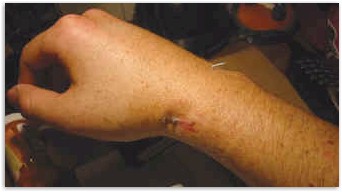| I
always have been a big fan of snowboarding, and, with 11 years of
experience, I consider myself proficient on the slopes. I just had been
commissioned when I decided to spend winter break in Mammothmy last
opportunity to do so before reporting to flight school in Pensacola in
March.
I arrived in Mammoth to find it hadn't snowed recently, and the
conditions were comparable to a spring skiing trip. At night, however, the
slush created by the heat of the day froze into layers of ice, setting the
stage for hard landings.
On my third day at the resort, I felt I knew the terrain well enough to
try some of the larger jumps. I was hitting one mogul particularly wellit
would launch me about 10 feet into the air. After my eighth trip over this
piece of terrain, I figured I probably should call it a day and go back to
the lodge. Instead, though, I decided to jump one more timejust for the
sake of pushing myself and proving I could handle this jump at full speed.
As I made my approach, I was thinking about my two previous jumps: I
hadn't had enough speed and had landed a little short of where I wanted to
be each time. I was determined this jump would be different. When I
launched off the lip, I immediately realized I was tilting back and to my
right. I figured when I came down, I could make some last-minute
corrections to my body position to absorb the impact from being 10 feet in
the air. It didn't take me long, however, to realize I was going to make a
hard landing.
When I touched down, I used my right wrist to correct for being canted
back and to my right. Once the rest of my board hit the icy landing, my
knees came up and smacked into my rib cage. I ended up riding away from
the landing, but I knew I might have broken something because the wind was
knocked out of me. I also had heard a "crack" as my knees hit my
chest.
 I rode to the nearest ski patrol and told him I had hurt myself. He
checked my rib cage and said I had broken a rib. However, my real surprise
came when I took off my glove. My fingers weren't moving, and I noticed my
wrist was deformed: It was pointing downward at an angle. I immediately
became queasy and went into shock. White stars were dancing all around my
peripheral vision when I passed out. I rode to the nearest ski patrol and told him I had hurt myself. He
checked my rib cage and said I had broken a rib. However, my real surprise
came when I took off my glove. My fingers weren't moving, and I noticed my
wrist was deformed: It was pointing downward at an angle. I immediately
became queasy and went into shock. White stars were dancing all around my
peripheral vision when I passed out.
An ambulance took me to the nearest hospital, where a doctor diagnosed
a broken rib on my right side and a broken right distal radius. I ended up
with a closed reduction on my wrist, which amounts to an orthopedic
surgeon putting temporary pins in your wrist. The best part of this
procedure is that the pins partly protrude from the skin, which creates a
conversational piece.
I no longer have the pins, but I still have the lessons I learned from
this fiasco. First, I knew in the back of my mind I shouldn't be trying
these types of jumps when I was scheduled to report to flight school in
three months. I also should have considered how a landing on ice could
alter my bone structure, especially from a height of 10 feet. I had
ignored both common sense and ORM. Finally, let me caution all readers to
wait until you get out of the Navy to practice for the X-Games. |
